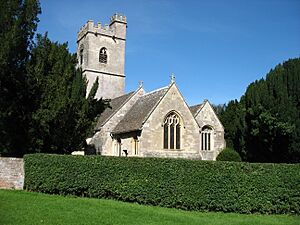St Andrew's Church, Whitminster facts for kids
St. Andrew's Church is an old and important church located in Whitminster, a town in Gloucestershire, England. This beautiful building was first built way back in the 1300s. Over the years, it has been changed and made bigger many times, from the late 1400s to the mid-1800s. It's special because it still has a traditional "Stoup." This is a stone basin that used to hold "Holy Water." Since 1955, St. Andrew's Church has been recognized as a "Grade II listed" building. This means it's a very important historical site that needs to be protected.
What the Church Looks Like
The church is built from strong, carefully cut stones. Its roof is made of slate, which is a type of rock that splits into thin, flat sheets. In the late 1400s, a tall tower was added to the church.
Inside, you can see several special plaques on the walls. These are called wall monuments. There are also parts of a beautiful gilded "reredos." A reredos is a decorated screen or wall behind the altar. This one was made by a company called Heaton, Butler and Bayne.
The church has a set of six bells that can be rung together. The oldest of these bells was made in 1634. St. Andrew's is one of only a few churches in Gloucestershire that still has a traditional "Stoup." This is a stone bowl used to hold "Holy Water."
The church is part of a group of churches called the Stroudwater Team. This team belongs to the Diocese of Gloucester, which is a larger church area.
A Look at History
The place where St. Andrew's Church stands has been used for worship since at least 1086. However, the oldest parts of the building you can see today are from the 1300s. The south porch, which is like a covered entrance, was probably built in the 1400s.
The church was made larger in 1842. A new section, called a north aisle, was added. This part was designed by an architect from Bristol named Thomas Foster. The tower was repaired and improved in 1844. Other parts of the church were also worked on in 1884 by Sir A.W. Blomfeld. Since then, the outside of the church has mostly stayed the same.
St. Andrew's Church has been officially recognized as a "Grade II listed" building since 1955. This means it's a special historic building that is protected.


